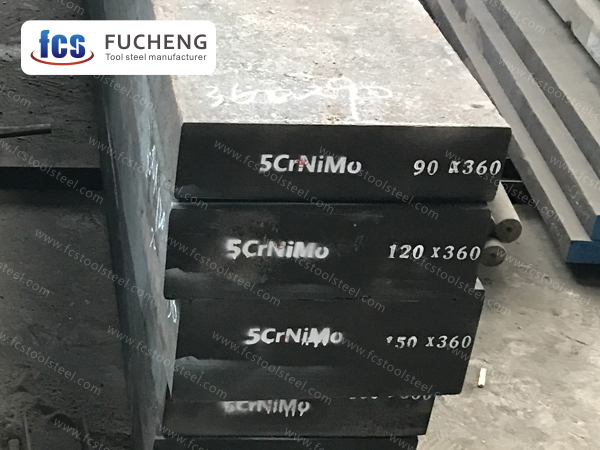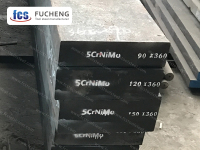
L6 Tool Steel | 1.2713 | 55NiCrMoV7 | SKT4 | BH224/5
L6 steel is a multi-purpose Oil hardened, heat-resistant and wear-resistant forged steel tool steel with very good toughness.
L6 tool steel is suitable for tools, molds and mechanical parts. They need a good combination of hardness and toughness. The relatively high nickel content makes the alloy have greater impact toughness than other ordinary oil hardening grades.
- fucheng steel
- China
- 1 Month
- 2000 Tons/Month
- Information
- Video
L6 STEEL
| Smelting and Manufacture Method: | LF+VD+Forged |
| Delivery Condition: | Annealed |
| Delivery hardness: | ≤212 HBS |
| UT Test Standard: | Sep 1921-84 Class3 D/d,E/e |
L6 STEEL GRADE COMPARISON AND CHEMICAL COMPOSITION COMPARISON
| Standard/Steel Grade | Chemical Composition(%) | |||||||
| C | Si | Mn | Cr | Mo | V | W | ||
| ASTM | L6 | 0.65~0.75 | 0.10~0.50 | 0.25~0.80 | 0.60~1.20 | ≤0.50 | - | 1.25~2.00 |
| DIN/W-Nr. | 55NiCrMoV6/1.2713 | 0.50~0.60 | 0.10~0.40 | 0.65~0.95 | 0.60~0.80 | 0.25~0.35 | 0.07~0.12 | 1.50~1.80 |
| JIS | SKT4 | 0.50~0.60 | 0.10~0.40 | 0.60~0.90 | 0.80~1.20 | - | 0.05~0.15 | 0.35~0.55 |
APPLICATION
L6 steel, as a high-quality tool steel, is mainly used in the manufacturing of cold work molds (such as stamping dies and shear knives), hot work molds (such as forging dies), and precision measuring tools that can withstand impact loads due to its excellent balance of toughness and wear resistance. L6 steel is particularly suitable for cutting tools (such as woodworking tools) and plastic forming molds that require both hardness and crack resistance, and plays an important role in industries such as automotive manufacturing and mechanical processing.
L6 STEEL CHARACTERISTICS
L6 steel is a medium carbon tool steel with nickel chromium tungsten as the main alloying element, and its unique composition design makes it occupy an important position in the industrial field. The alloy ratio of L6 steel has been precisely calculated to achieve an ideal balance between hardness and toughness, making it the preferred material for mold and tool manufacturing.
L6 steel can maintain stable cutting edges under long-term friction conditions. This characteristic is particularly suitable for manufacturing industrial cutting tools that require repeated wear and tear, such as saw blades and stamping dies. The addition of chromium to L6 steel enhances its hardenability, ensuring even hardness distribution for large section workpieces.
The nickel element endows L6 steel with excellent toughness, making it less prone to cracking when subjected to impact loads. This feature makes it an ideal choice for manufacturing heavy-duty forging dies, especially in high-pressure working environments such as automotive parts forging. The pre hardening characteristics of L6 steel simplify the subsequent processing flow and reduce the risk of heat treatment deformation.
The processing performance of L6 steel is excellent, and it can still be machined even in the quenched and tempered state. This feature significantly reduces production costs, making it possible to manufacture molds with complex shapes. The welding performance of L6 steel is relatively good, but preheating and post heating measures need to be taken to avoid cracks.
In terms of heat treatment, L6 steel exhibits a wide process window. By appropriate quenching and tempering processes, a hardness range of 52-62HRC can be obtained to meet the needs of different application scenarios. The existence of secondary hardening phenomenon in L6 steel enables it to maintain high hardness even during high-temperature tempering.
Corrosion resistance is the relative weakness of L6 steel, which is prone to rusting in humid environments. This feature requires appropriate protective measures to be taken during use, such as chrome plating or coating with rust proof oil. L6 steel requires regular maintenance by users for rust prevention in tool applications.
The microstructure of L6 steel is dense and uniform, with fine distribution of carbides. This microstructure ensures the isotropy of steel and reduces performance differences caused by directionality. After appropriate heat treatment, L6 steel can obtain an ideal martensitic matrix structure.
Under extreme temperature conditions, L6 steel exhibits good dimensional stability. This feature makes it suitable for molds with large temperature changes, such as hot work molds. The thermal fatigue resistance of L6 steel is also outstanding, and it can withstand repeated heating and cooling conditions.









